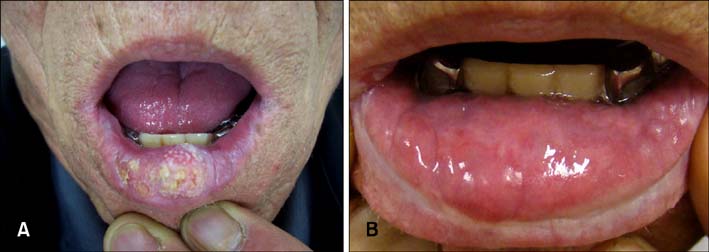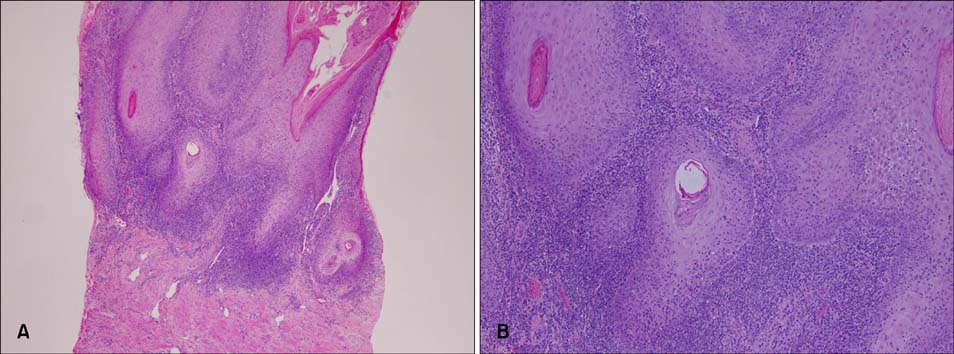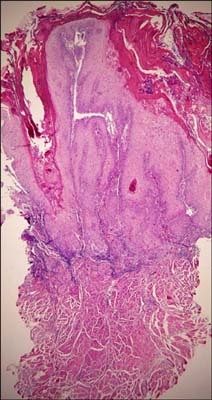Ann Dermatol.
2011 Sep;23(Suppl 1):S68-S71. 10.5021/ad.2011.23.S1.S68.
Treatment of Verrucous Carcinoma of the Lower Lip with Topical Imiquimod (Aldara(R)) and Debulking Therapy
- Affiliations
-
- 1Department of Dermatology, Dongguk University Ilsan Hospital, College of Medicine, Dongguk University, Goyang, Korea. lay5604@naver.com
- 2Department of Dermatology, Chung-Ang University of Medicine, Seoul, Korea.
- KMID: 2156755
- DOI: http://doi.org/10.5021/ad.2011.23.S1.S68
Abstract
- Verrucous carcinoma is an unusual, non-metastasizing, distinct variant of squamous cell carcinoma composed of four subtypes according to the site of occurrence: oral type, anogenital type, plantar type, and other cutaneous sites. Oral type verrucous carcinoma usually shows slow progression with a low incidence of metastases. Treatment of verrcous carcinoma is challenging; multiple medical and surgical therapies are often attempted, with limited success. We reported on 2 cases of verrucous carcinoma of the lip treated with topical imiquimod and debulking therapy.
Keyword
MeSH Terms
Figure
Cited by 1 articles
-
Subungual Verrucous Carcinoma of the Right Little Finger with Underlying Bony Invasion
Hyun Bo Sim, Soo Yuhl Chae, Yong Hyun Jang, Seok-Jong Lee, Do Won Kim, Weon Ju Lee
Ann Dermatol. 2016;28(5):657-659. doi: 10.5021/ad.2016.28.5.657.
Reference
-
1. Ackerman LV. Verrucous carcinoma of the oral cavity. Surgery. 1948. 23:670–678.2. Freedberg IM, Eisen AZ, Wolff K, Austen KF, Glidsmith LA, Katz SI, et al. Fitzpatrick's dermatology in general medicine. 2003. 6th ed. New York: Mcgraw-Hill;742–743.3. Creasman C, Haas PA, Fox TA Jr, Balazs M. Malignant transformation of anorectal giant condyloma acuminatum (Buschke-Loewenstein tumor). Dis Colon Rectum. 1989. 32:481–487.
Article4. Kao GF, Graham JH, Helwig EB. Carcinoma cuniculatum (verrucous carcinoma of the skin): a clinicopathologic study of 46 cases with ultrastructural observations. Cancer. 1982. 49:2395–2403.
Article5. Diaz-Pérez JL, Moreno J, Burgos J. Ackerman's verrucous carcinoma on the lower lip. Med Cutan Ibero Lat Am. 1981. 9:105–110.6. Krutchkoff DJ, Chen JK, Eisenberg E, Katz RV. Oral cancer: a survey of 566 cases from the University of Connecticut Oral Pathology Biopsy Service, 1975-1986. Oral Surg Oral Med Oral Pathol. 1990. 70:192–198.
Article7. Zielonka E, Goldschmidt D, de Fontaine S. Verrucous carcinoma or epithelioma cuniculatum plantare. Eur J Surg Oncol. 1997. 23:86–87.
Article8. Garven TC, Thelmo WL, Victor J, Pertschuk L. Verrucous carcinoma of the leg positive for human papillomavirus DNA 11 and 18: a case report. Hum Pathol. 1991. 22:1170–1173.
Article9. Knobler RM, Schneider S, Neumann RA, Bodemer W, Radlwimmer B, Aberer E, et al. DNA dot-blot hybridization implicates human papillomavirus type 11-DNA in epithelioma cuniculatum. J Med Virol. 1989. 29:33–37.10. Stephen JM, Vincent RH. Plastic surgery. 2006. 6th ed. Philadelphia: Elsevier Inc;799–800.11. Marks R, Gebauer K, Shumack S, Amies M, Bryden J, Fox TL, et al. Imiquimod 5% cream in the treatment of superficial basal cell carcinoma: results of a multicenter 6-week dose-response trial. J Am Acad Dermatol. 2001. 44:807–813.
Article12. Mackenzie-Wood A, Kossard S, de Launey J, Wilkinson B, Owens ML. Imiquimod 5% cream in the treatment of Bowen's disease. J Am Acad Dermatol. 2001. 44:462–470.
Article13. Kaspari M, Gutzmer R, Kiehl P, Dumke P, Kapp A, Brodersen JP. Imiquimod 5% cream in the treatment of human papillomavirus-16-positive erythroplasia of Queyrat. Dermatology. 2002. 205:67–69.
Article14. Steinmann A, Funk JO, Schuler G, von den Driesch P. Topical imiquimod treatment of a cutaneous melanoma metastasis. J Am Acad Dermatol. 2000. 43:555–556.
Article15. Bong AB, Bonnekoh B, Franke I, Schön MP, Ulrich J, Gollnick H. Imiquimod, a topical immune response modifier, in the treatment of cutaneous metastases of malignant melanoma. Dermatology. 2002. 205:135–138.
Article16. Tyring S. Imiquimod applied topically: a novel immune response modifier. Skin Therapy Lett. 2001. 6:1–4.17. Hengge UR, Ruzicka T. Topical immunomodulation in dermatology: potential of toll-like receptor agonists. Dermatol Surg. 2004. 30:1101–1112.
Article18. Heinzerling LM, Kempf W, Kamarashev J, Hafner J, Nestle FO. Treatment of verrucous carcinoma with imiquimod and CO2 laser ablation. Dermatology. 2003. 207:119–122.
Article19. Schalock PC, Kornik RI, Baughman RD, Chapman MS. Treatment of verrucous carcinoma with topical imiquimod. J Am Acad Dermatol. 2006. 54:5 Suppl. S233–S235.
Article
- Full Text Links
- Actions
-
Cited
- CITED
-
- Close
- Share
- Similar articles
-
- A Case of Verrucous Carcinoma on the Lower Lip
- A Case of Verrucous Carcinoma Improved by 5% Imiquimod Cream
- A Case of Verrucous Carcinoma Treated by 5% Imiquimod Cream
- A Case of Actinic Keratosis Treated with Topical Imiquimod
- Treatment of Keratoacanthoma with 5% Imiquimod Cream and Review of the Previous Report





